Who found the water on the Moon?
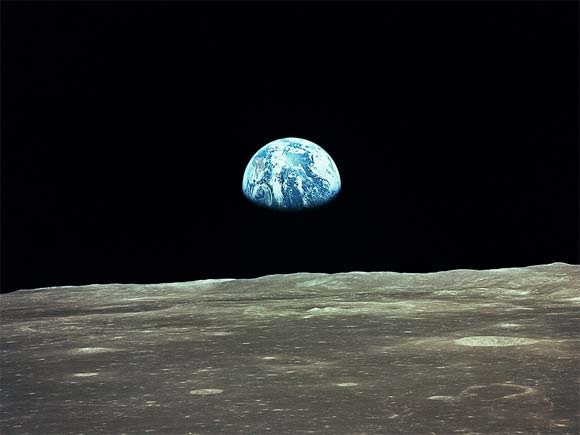
At just over two tonnes, the second stage of an Atlas V rocket, makes for an unusual ‘kinetic probe’. Nonetheless on October 9, 2009 NASA deliberately impacted a spent Centaur rocket into the lunar south polar crater Cabeus. The target area was a permanently shadowed region within this crater. The impact, not surprisingly, ejected a spectacular plume of debris, dust and vapour.
Science experiment, observe the system, perturb it, and measure what happens
The US scientists had thrown a heavy object at the Moon. They then threw all the instruments possible to monitor the impact. The prize was a decades-long search to directly find water on the Moon.
The impact would have been majestic to watch. Picture those slow motion images of Apollo astronauts on the Moon. Hold that thought and then imagine the impact. An observer could marvel at the slow motion, low gravity, return of the dust and debris cloud to the Moon’s surface. If you could see in the infra-red, the impact flash lasts for 10 seconds. There is a cloud of debris, dust, and vapour rising. At eight seconds the the ejecta cloud is 4.5km in diameter, in the ultra-violet spectrum, the plume is 10km in diameter. At 20 seconds after impact the ejecta cloud was is at its maximum diameter of 8.5km and the plume has reduced to little less than 10km.
The observer would be watching a science experiment on a grand scale.
The observer in this experiment was neither you nor I, it was a trailing “shepherding spacecraft”. The Centaur had propelled NASA’s Lunar Reconnaissance Orbiter and Lunar Crater Observation and Sensing Satellite to the Moon. Shortly after launch the Lunar Reconnaissance Orbiter had separated to go on its own mission. Once in lunar orbit the Centaur had vented its remaining fuel. Control was then assumed, for the next four months, by the Lunar Crater Observation and Sensing Satellite as the shepherding satellite. During this next period the shepherding satellite maneuvered the Centaur to allow the Sun to bake-out residual water and volatiles. This was to ensure that no contaminant chemicals were passengers to the lunar impact site. The Centaur’s fuel was a volatile combination of liquid hydrogen and liquid oxygen, both chemicals that were to be scanned for in the impact cloud. The Lunar Crater Observation and Sensing Satellite also calibrated its instruments, then targeted the Centaur to impact with the Moon. Four months of meticulous preparation.
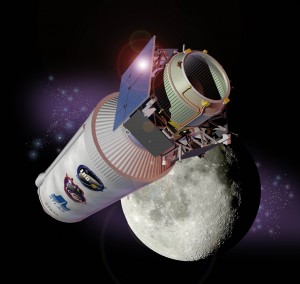
The Lunar Crater Observation and Sensing Satellite carried nine instruments, including cameras, spectrometers and a radiometer. The spectrometers measured the reflected light at different wavelengths. These enabled the identification of the chemicals present in the ejected cloud.
Near-infrared absorbance attributeble to water vapour and ice, and ultraviolet emissions attributable to hydroxyl radicals (OH-) support the presence of water in the debris. The researchers determined from these observations that there was over 5%, by mass, of water ice in the lunar regolith of the impact site. Certainly this is small by terrestrial soil standards, but more substantial than most earlier estimates.
Over a year after the impact, in the October 22, 2010 issue of the journal Science, the results of this experiment were delivered to the world’s attention. This certainly marked a defining moment for lunar scientists, directly confirming the availability of water on the moon. It was however neither the first nor last word on this.
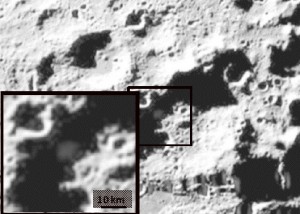
Early attempts
Since the first lunar sample were carried back to earth by Apollo astronauts in the late 1960s, scientists have operated under the presumption that the moon was entirely dry. In total 382kg of lunar material was bought to Earth by the Apollo missions astronauts and a further 0.32kg by the unmanned USSR Lunar missions. New analyses of these rocks with improved analytical techniques have made it possible to perform highly sensitive isotopic measurements on very small lunar grains. These analyses are revealing water in Apollo samples that were once thought to be dry.
Well before these new studies, scientists had been puzzling about why more water was not seen on the moon. It was thought that volatile materials, such as water, could be accumulating at the moon’s permanently shaded polar regions. Here they could be trapped for geological periods of time without significant loss. The in 1998, the orbiting Lunar Prospector spacecraft measured the the abundance of elements on the moon’s surface using neutron spectroscopy. This provided compelling evidence for enhanced hydrogen concentrations, and by inference water, at both of the lunar poles.
In 1999 the Cassini spacecraft flew by the moon on its way to Saturn. It turned its Visual and Infrared Mapping Spectrometer to the moon. By measuring the surface reflectance of light from the moon scientists found absorption attributed to hydroxyl and water on the sunlit surface of the moon. These results were not published until 10 years later, in October 2009. The reason was renewed interest in water on the moon.
On October 22, 2008 Chandrayaan-1 was launched on a lunar mission by the Indian Space Research Organisation. One of its major scientific missions was to look for water on the moon. It had three different instruments ready to make 2008-10 an interesting period for lunar water exploration.
Chandrayaan-1, India’s lunar water finder
The Chandrayaan-1 story is told in detail elsewhere. Here I intend to showcase the marvelous outcome of Chandrayaan-1’s water finding experiments. Perhaps the most exciting of all these was one of the simplest. This was the CHandra’s Altitudinal Composition Explorer (CHACE) on board the Moon Impact Probe.
On November 14 2008 (the birthday of the late Pandit Jawaharlal Nehru, India’s 1st Prime Minister) the Moon Impact Probe became the first Indian built object to reach the surface of the Moon. The probe was a 34kg box-shaped object containing a video image system, radar altimeter, and The CHACE mass spectrometer.
Symbolically the Indian tricolour was painted on three sides of the Moon Impact Probe. This enables India to also lay claim to having the “Indian tricolour placed on the Moon”. Needless to say that “placing” in this case was a hard landing in the Moon’s south polar region near the Shackleton crater, flying over the Malapert mountain en route.
The CHACE mass spectrometer took 650 spectra of the tenuous lunar atmosphere during its 1487 second, 98km, plunge to the lunar surface. Tenuous is right the atmosphere even on the sunlit side is only 7/10,000,000,000th of the Earth’s atmosphere.
The mass spectrometer was tuned to look find water and direct evidence of water it did find. The team leader of the experiment, Dr S M Ahmed, remembers, “We all were jumping when we saw water was literally pouring out of our instrument” on 14th November, 2008. The Indian scientists had established that the dominant species of the tenuous sunlit lunar atmosphere were H2O, N2 and CO2.
These results were not published until 6 August, 2010 after being confirmed (on August 22, 2009) and complemented by the results from two of the other 11 instruments that formed the scientific payload of Chandrayaan-1. Amongst the instruments on Chandrayaan-1 were the Moon Mineralogy Mapper (M3) and Miniature Synthetic Aperture Radar (Mini-SAR) from NASA. The Moon Mineralogy Mapper has covered nearly 97% of the lunar surface, some of the other instruments have covered more than 90%.
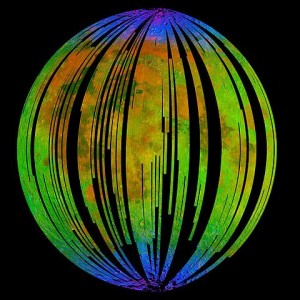
A detailed analysis of the data obtained from Moon Mineralogy Mapper, has clearly indicated the presence of water molecules on the lunar surface extending from the lunar poles to about 60 degrees latitude. Hydroxyl, a molecule consisting of one oxygen atom and one hydrogen atom, was also found in the lunar soil.
The Moon Mineralogy Mapper measured the intensity of reflected sunlight from the lunar surface at infrared wavelengths, splitting the spectral colours of the lunar surface into small enough bits revealing finer details of the lunar surface composition. This enabled identification of the presence of various minerals on the lunar surface that have characteristic spectral signature at specific wavelengths. Since reflection of sunlight occurs near the moon’s surface, such studies provide information on the mineral composition of the top crust of a few millimeters of the lunar surface.
The findings from Moon Mineralogy Mapper clearly showed a marked signature in the infrared region of 2.7 to 3.2 micron in the absorption spectrum, which provided a clear indication of the presence of hydroxyl (OH) and water (H2O) molecules on the surface of the Moon closer to the polar region. It was also concluded that they are in the form of a thin layer embedded in rocks and chemical compounds on the surface of the moon and the quantity is also extremely small of the order of about 700 ppm.
These molecules could have come from the impact of comets or radiation from the sun. But the most probable source could be low energy hydrogen carried by solar wind impacting on the minerals on lunar surface. This in turn could form OH or H2O molecules by deriving the oxygen from metal oxide.
Following these findings, the scientific team revisited the data from NASA’s Deep Impact Mission launched in 2005 which carried an instrument similar to Moon Mineralogy Mapper. Deep Impact Probe observed the moon during the period June 2 to 9, 2009. As previously mentioned the Moon Mineralogy Mapper observations are further strengthened by results obtained from the analysis of archived data of the Cassini probe.
Further to these findings, ice was detected in small polar craters (2-15km in diameter) that are not visible from the Earth. These north polar craters have sub-surface water ice located at their base. The interior of these craters is in permanent shadow from the Sun. Although the total amount of ice depends on its thickness in each crater, it’s estimated there could be at least 600 million metric tons of water ice.
This water was detected using the mini-SAR instrument. Mini-SAR is a lightweight (less than 10 kg) synthetic aperture imaging radar. It uses the polarization properties of reflected radio waves to characterize surface properties. Looking at their internal roughness this instrument could detect whether craters were newly formed. It found the water by looking for craters that gave anomalous signals. Signals that were consistent, however, with them having water in their base.
How did the water come to be there?
Using methods, both direct and indirect, we now know that water is present on the moon. We even have a good estimate of the amount of it that is present and were it is located. How were these reservoirs of lunar water formed? Studies published in 2011 suggest that water was acquired by both the Earth and Moon after the Moon’s formation. Geochemical analysis of the rocks retrieved by the Apollo missions show the lunar and terrestrial water are isotopically distinct. It remains a conundrum how the Earth and the Moon could have sampled water from different origins.
The conventional explanation for ice in polar craters like Cabeus – whose floor is in permanent shadow and thus hovers near 40 degrees above absolute zero – is that icy asteroids or comets strike somewhere on the Moon, and some of the resulting water vapour reaches a permanently shadowed crater’s deep chill and freezes out there. This cold trapping would only fill the empty space in the regolith, not form nearly pure ice. Regolith is the name for the lunar ‘soil’, more like dust as it contains no organic matter that would make it truly soil.
No one knows how the subsurface ice would form. Now that it has been blasted into view, its presence confirmed, scientists can move their thoughts to determining how it came to be there, in the form that it is.
Still that is the beauty and fun in science, understanding how reality comes to be the way it is.
Water on the Moon, so what?
So why the interest in whether there is water on the moon? I would suggest that there is a one word succinct answer to this question; curiosity. Science by its nature is a curiosity-driven enterprise. How did the universe come to be the way it is? This I suspect is, ultimately, the question behind most if not all scientific enterprise. The quest for water on the moon was also driven by the need to sustain astronauts returning to the Moon. Readily accessible water is a necessity to sustain a moon-base. Human exploration, although always framed in economic, or national, or in this case human-kind language is, I suspect, deeply motivated by human curiosity.
Since then, the Obama-administration and now Congress have turned their backs on sending humans to the Moon. This decades-long push by NASA, with help from their friends, to find water will benefit the others with lunar aspirations. The Indians have a Space 2025 vision to follow up Chandrayaan-1 with further unmanned Moon voyages. In addition they have recently announced that the Indian Air Force has responsibility for developing a viable astronaut training programme for the purpose of undertaking future manned spaceflights.
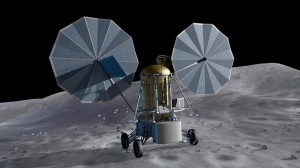
The Russian newspapers have recently trumpeted that Russia will put men on the Moon by 2030. Although officially Russia’s most up to date planning covers to the year 2015. Japan has a proposed unmanned lunar probe for launch ‘some time in the 2010 decade’. This follows up on a successful September 14, 2007 launch of its lunar orbiter, Kaguya. Meanwhile the first spacecraft of the Chinese lunar exploration programme, the unmanned lunar orbiter Chang’e 1, was successfully launched from Xichang Satellite Launch Center on October 24, 2007. A second unmanned orbiter, Chang’e 2, was launched successfully on October 1, 2010. Chang’e 3, China’s first lunar rover, is expected to launch in 2013. A manned expedition may occur in 2025-2030.
The 2020-30 decades could herald an intense, multinational, focus on water on the Moon.
 Follow
Follow
The human quest to heavenly bodies has culminated in Neil Armstrong stepping on the Moon. The same urge to know more intrigued every human including a developing country like India. We were some 3-4 hand picked enthusiasts (with ZERO experience in space borne instrumentation) to work on the development of the state-of-the-art instrument to sample the lunar ambiance during the descent of Moon Impact Probe. The feeling of seeing the end product to on the MOON was so compelling that we always used to walk (run) one extra mile to make it to the goal.
When we saw signatures of WATER (the first among the human race to do so); our team’s senior scientist in his 59th year was jumping like a small kid. Today, I know, why he was doing it. As I write this note here; I know that the credit of finding water on the Moon is not in our kitty; but when ever I look at the Moon deep in my heart what I feel is “in the court of LORD, it was my team which had seen Peak#18 Literally pouring out of the instrument”.
S.M.Ahmed, Team leader, CHACE payload
Dr Ahmed I thank you for your comment. I agree the quest to explore the Moon, Mars, the rest of the Solar System to the other galaxies is one that generates much human curiosity and endeavor. I can appreciate your teams excitement at the results of your CHACE experiment, in themselves a great achievement.
The question of primacy, who discovered something first, is also not always the most important one regarding scientific achievement. As Isaac Newton said in a letter (February 5, 1675) to Robert Hooke, “If I have seen further it is by standing on the shoulders of giants.” Finding the water on the Moon was an achievement that stood on the shoulders of many. At the same time every scientist hopes that at some stage during their careers that they too can ‘jump around like a small kid’ with the joy that they have found something that no one else in the world has ever seen!
I wonder what Chandrayaan-2 will discover?